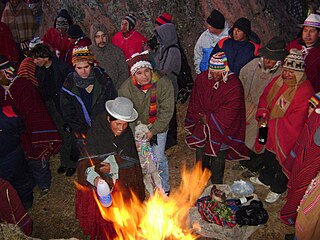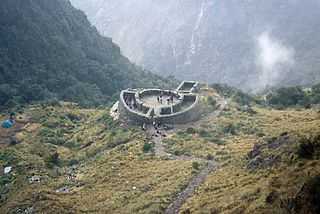
Cochabamba, from Quechua qucha or qhucha, meaning "lake", pampa meaning "plain", is one of the nine departments of Bolivia. It is known to be the "granary" of the country because of its variety of agricultural products from its geographical position. It has an area of 55,631 km2. Its population in the 2012 census was 1,758,143. Its capital is the city of Cochabamba, known as the "City of Eternal Spring" and "The Garden City" because of its spring-like temperatures all year.
In recent years, Peru has revised the official spelling for place-names originating from Aymara and the Quechuan languages. A standardized alphabet for done Quechua was adopted by the Peruvian government in 1975; a revision in 1985 moved to a three-vowel orthography.

Inkallaqta is a monumental Inca site in central Bolivia. It is located in the Cochabamba Department, Carrasco Province, Pocona Municipality, approximately 130 kilometers east of Cochabamba. It was most recently excavated by Larry Coben. He believes that the site was used to perform rites for the ceremonial calendar. The site has several important structures such as the Kallanka. It was the largest single roofed room in the western hemisphere when it was built, and measures 78 by 25 meters. There's also an ushnu or a ritual platform on the site. The Torreon of Inkallaqta is also located on this site. Located at the western side of the site this six sided structure supposedly had calendrical or astronomical significance. There is a zigzag wall immediately north of the site which is meant to mark and protect it.

Quillacollo is a province in the Cochabamba Department, Bolivia. It is known for its festival in August where people from all over Bolivia come and pay homage to the Virgin of Urqupiña. Quillacollo is said to be one of the fastest-growing cities in Bolivia.
Sipe Sipe Municipality is the second municipal section of the Quillacollo Province in the Cochabamba Department, Bolivia. Its seat is Sipe Sipe. At the time of census 2001 the municipality had 31,337 inhabitants.

Willkakuti, Machaq Mara, Mara T'aqa, Jach'a Laymi or Pacha Kuti is an Aymara celebration in Bolivia, Chile and the Puno Region of Southern Peru which takes place annually on 21 June, commemorating the winter solstice in the Southern Hemisphere.

Tarmatambo or Tarmatampu is an archaeological site in the Junín Region in Peru. It is located in the Tarma Province, Tarma District, in the community of the same name. The site was declared a National Cultural Heritage by Resolución Directoral Nacional No. 040/INC on January 29, 2002.

Runkuraqay or Runku Raqay is an archaeological site on a mountain of the same name in Peru located in the Cusco Region, Urubamba Province, Machupicchu District. It is situated southeast of the archaeological site Machu Picchu and south of the Vilcanota river. The ruins lie on the southern slope of the mountain Runkuraqay near the Runkuraqay pass, northeast of the archaeological site Sayacmarca and southeast of the site Qunchamarka.

Huillca Raccay or Huillca Racay is an archaeological site in Peru located in the Cusco Region, Urubamba Province, Ollantaytambo District. It is situated southeast of the archaeological site Patallacta above the right bank of the little river Pampa Qhawa, an affluent of the Vilcanota River, near the village Chamana.
Inka Raqay or Inkaraqay is a small archaeological complex in Peru. It lies in the Apurímac Region, Abancay Province, Cachora District. Inka Raqay is situated at a height of 3,590 metres (11,778 ft) on the northern slope of Inka Wasi south of the archaeological site of Choquequirao, above the Apurímac River.
Qurimarka is an archaeological site in Peru. It is situated in the Apurímac Region, Abancay Province, Huanipaca District.

Inka Mach'ay is an archaeological site in Bolivia. It is situated in the Chuquisaca Department, Oropeza Province, Sucre Municipality, at a height of 3,510 metres (11,516 ft). Inka Mach'ay was declared a National Monument on May 27, 1958, by Supreme Decrete No. 4954.

Incahuasi is a mountain in the Vilcabamba mountain range in the Andes of Peru whose summit reaches 4,315 metres (14,157 ft) above sea level. It is situated in the Apurímac Region, Abancay Province, Cachora District. The mountain lies on the bank of the Apurímac River, opposite the archaeological site of Choquequirao. On its northern slope there is a small archaeological site named Inka Raqay. Tourists are also attracted by the viewpoint of Incahuasi which provides good views of the Apurímac valley, Choquequirao and Padreyoc.
Inka Murata is an archaeological site in the Altiplano of Bolivia. It is located in the Oruro Department, Litoral Province, Escara Municipality, in the community of Escara. The site with the adjacent burial towers (chullpa) was declared a National Historical Monument by Law 3833 on January 23, 2008.
Inkachaka or Inka Chaka is an archaeological site in Bolivia. It is situated in the Cochabamba Department, Chapare Province, Colomi Municipality. The site was declared a Cultural Heritage of Bolivia by Law 2533 on October 24, 2003.

Maray Qalla is an archaeological site in Peru. It is situated in the Ancash Region, Carlos Fermín Fitzcarrald Province. Maray Qalla lies at a section of the Qhapaq Ñan, the Inca road system.
Inka Raqay hispanicized spelling Incaraqay) or Allqu Willka(Allcuhuillca, Alkowillka) is an archaeological site in the Ayacucho Region in Peru. It is located in the Huanta Province, Iguain District, on top of the mountain named Allqu Willka.
Inka Raqay or Inkaraqay may refer to:
Waraqu Urqu is an archaeological site in the Ayacucho Region in Peru. The Chanka site lies in the La Mar Province, in the west of the Anco District, near Sacha Raqay (Sacharajay, Sacharaccay). It is situated at a height of about 3,852 m (12,638 ft).
Yuraq Yaku is a 3,232-metre-high (10,604 ft) mountain in the Bolivian Andes. It is located in the Cochabamba Department, Quillacollo Province, Sipe Sipe Municipality. Yuraq Yaku lies southeast of Inka Laqaya.










